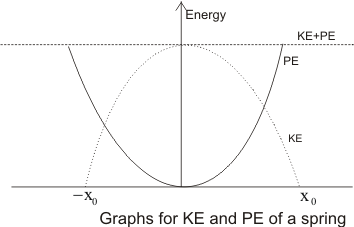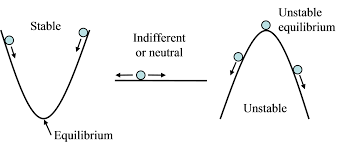Diagram
Plots of potential energy, kinetic energy and total energy v/s position

Total energy of an isolated system is constant.
For mechanical energy,
where are the total, kinetic and potential energies.
Variation of energies with position for a spring is shown in the attached plot.
Note:
Kinetic energy is always greater than or equal to zero. This property must be satisfied in energy v/s position plot.
For mechanical energy,
where are the total, kinetic and potential energies.
Variation of energies with position for a spring is shown in the attached plot.
Note:
Kinetic energy is always greater than or equal to zero. This property must be satisfied in energy v/s position plot.
Diagram
Plot of potential energy v/s position

Force is defined as negative of the slope of potential energy v/s position plot.
Example:
Consider the given plot defined by the equation:
Between A and B, slope is positive, so force is negative.
Between B and C, slope is negative, so force is positive.
Definition
Equilibrium point using potential energy plot

If slope of the potential energy v/s position plot is zero, then .
For example, in the given plot, B corresponds to the point of equilibrium.
Diagram
Stable and unstable equilibrium points from potential energy plot

Stable equilibrium means that, with small deviations of the body from this state, forces or moments of forces emerge which tend to return the body to the state of equilibrium. A convex minima () in potential energy v/s position plot refers to a point in unstable equilibrium.
Unstable equilibrium means that, with small deviations of the body from this state, forces or moments of forces emerge which tend to return the body away from the state of equilibrium. A concave maxima () in potential energy v/s position plot refers to a point in unstable equilibrium.
Unstable equilibrium means that, with small deviations of the body from this state, forces or moments of forces emerge which tend to return the body away from the state of equilibrium. A concave maxima () in potential energy v/s position plot refers to a point in unstable equilibrium.
Formula
Equation of Displacement
Equation of displacement:
The amplitude of a particle performing S.H.M. is . What is the displacement at which its velocity will be half of the maximum velocity?
Solution:
so, amplitude is
The amplitude of a particle performing S.H.M. is . What is the displacement at which its velocity will be half of the maximum velocity?
Solution:
so, amplitude is
Example
Displacement as projection of circular motion along a straight line

Example: Figures given correspond to two circular motions. The radius of the circle, the period of revolution, the initial position, and the sense of revolution (i.e.
clockwise or anti-clockwise) are indicated on each figure.Obtain the corresponding simple harmonic motions of the x-projection of the radius vector of the revolving particle P, in each case.
Solution:
(a) Time period,
Amplitude,
At time, , the radius vector OP makes an angle with the positive x-axis, i.e., phase angle
Therefore, the equation of simple harmonic motion for the x-projection of OP, at the time t, is given by the displacement equation:
(b) Time Period, Amplitude, At time , OP makes an angle with the x-axis, in the anticlockwise direction, Hence, phase angle Therefore, the equation of simple harmonic motion for the x-projection of OP, at the time , is given as:
clockwise or anti-clockwise) are indicated on each figure.Obtain the corresponding simple harmonic motions of the x-projection of the radius vector of the revolving particle P, in each case.
Solution:
(a) Time period,
Amplitude,
At time, , the radius vector OP makes an angle with the positive x-axis, i.e., phase angle
Therefore, the equation of simple harmonic motion for the x-projection of OP, at the time t, is given by the displacement equation:
(b) Time Period, Amplitude, At time , OP makes an angle with the x-axis, in the anticlockwise direction, Hence, phase angle Therefore, the equation of simple harmonic motion for the x-projection of OP, at the time , is given as:
Example
Problem on velocity and amplitude of mass attched to spring
Example: A block with mass is connected by a mass less spring with stiffness constant to a rigid wall and moves without friction on a horizontal surface. The block oscillates with small amplitude A about an equilibrium position . Consider two cases: (i) when the block is at ; and (ii) when the block is at . In both the cases, a particle with mass is softly placed on the block after which they stick to each other.
Which of the following statement(s) is(are) true about the motion after the mass is placed on the mass ?
Solution:
In case I,From Conservation of momentum,
In case II,
in both the cases.
Total energy decreases in first case where as remain same in 2nd case.
Instantaneous speed at decreases in both case.
Which of the following statement(s) is(are) true about the motion after the mass is placed on the mass ?
Solution:
In case I,From Conservation of momentum,
In case II,
in both the cases.
Total energy decreases in first case where as remain same in 2nd case.
Instantaneous speed at decreases in both case.
Example
Write force equations of an arrangement of springs in parallel and calculate equivalent spring constant
Example: Two blocks and attached to the ends of a spring constant 1120N/m are placed on a smooth horizontal plane with the spring undeformed. Simultaneously, velocities of 3m/s and 10m/s along the line of the spring in the same direction are imparted to and , then find the maximum extension of the spring.
Solution:
The maximum elongation occurs when the velocity of both the particles becomes equal. Since there is no external force acting in the horizontal direction (for the
blocks + spring system), thus the linear momentum is conserved in horizontal direction:
If the final common velocity is
Also applying law of conservation of energy for the system (work done by non-conservative force is zero):
Initial Energy Final Energy
Solving the above equation we get cm
Also it can be observed that the compression and expansion occur alternately.
Solution:
The maximum elongation occurs when the velocity of both the particles becomes equal. Since there is no external force acting in the horizontal direction (for the
blocks + spring system), thus the linear momentum is conserved in horizontal direction:
If the final common velocity is
Also applying law of conservation of energy for the system (work done by non-conservative force is zero):
Initial Energy Final Energy
Solving the above equation we get cm
Also it can be observed that the compression and expansion occur alternately.
Example
Application of conservation of energy for spring in horizontal plane
Example:
A block of mass is on a smooth horizontal surface. A light spring of force constant has one end rigidly attached to a vertical wall and lying on that horizontal surface. Now the block is moved towards the wall compressing the spring over a distance of and then suddenly released. By the time the spring regains its natural length and breaks contact with the block, the velocity acquired by the block will be?
Solution:Using conservation of energy
Initial Final
i.espringblock
A block of mass is on a smooth horizontal surface. A light spring of force constant has one end rigidly attached to a vertical wall and lying on that horizontal surface. Now the block is moved towards the wall compressing the spring over a distance of and then suddenly released. By the time the spring regains its natural length and breaks contact with the block, the velocity acquired by the block will be?
Solution:Using conservation of energy
Initial Final
i.espringblock
Example
Time period from force equations

Example:If a particle slides back and forth between two smooth planes as shown in the figure, then find the time period of oscillations if the height is .
Solution:
By equation of motion
So, this much time is taken to reach at bottom from height
So, time period will be
So, its is an oscillatory motion with time period . It is not SHM because force is not proportional to displacement, it is constant of magnitude
Solution:
By equation of motion
So, this much time is taken to reach at bottom from height
So, time period will be
So, its is an oscillatory motion with time period . It is not SHM because force is not proportional to displacement, it is constant of magnitude
| BookMarks |
Page 11 Page 12 Page 13 Page 14
0 Comments
Post a Comment